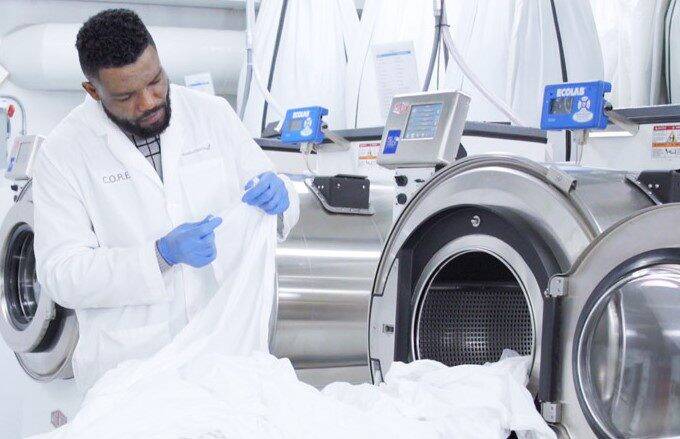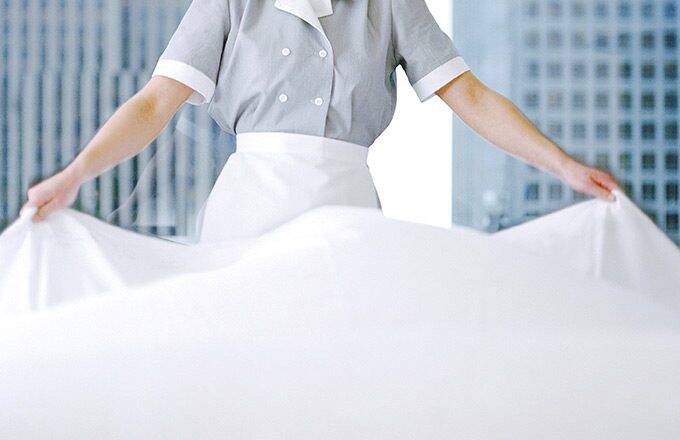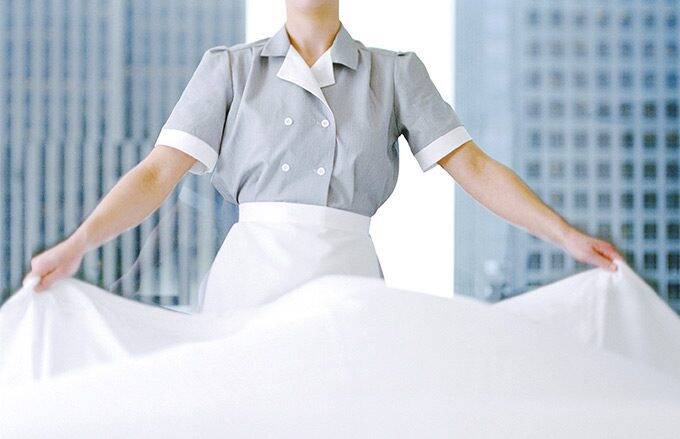June 7, 2022
When to Replace Used Linen

It’s no secret that hospitality linens don’t last forever. Even the most durable bedding and towels must eventually be replaced due to high usage and harsh industrial laundering. Whether due to a stubborn stain, a tear, or discoloration, it is important that your laundry and housekeeping staff know when to replace used linen.
What are the dangers of not replacing used linen?
Replacing used linen too late results in a negative guest experience. Bed and bath linen will be touched by your guests for a significant portion of their stay. Because of this, they will also be closely scrutinized. If frayed towels or stained bedding make their way to guest rooms, you might receive complaints or negative online reviews. The cost of negative reviews can be extensive, with a recent article by Customer Alliance stating that hotels can risk losing up to 22% of bookings due to negative reviews. For these reasons, perhaps more than any other room amenity, overused linen is a liability to your guest experience.
Is it possible to replace used linen too soon?
Our outside textile consultants visit hotel laundries nearly every day. One of the most surprising discoveries they have made is that linen items are often discarded well before the end of their useful life. While you never want to replace used linen too late, it is also possible to discard items too soon. Minor stains, frays, and unraveled hems are often correctable. And even varying levels of whiteness that are obvious in the laundry room are often impossible to see when the product is in the guest room. Knowing which imperfections are acceptable will enable your laundry staff to extend the useful life of your linen and keep your cost per use as low as possible, without affecting your guest experience.
Common signs of aging linen:
Download our quick reference guide or read below to learn some of the most common warning signs of aging linen:
- Frays or unraveled hems: Frays or unraveled hems can be one of the first signs of linen wear. This can be caused by a variety of factors – loosening of the weave over time, laundry damage, or friction from heavy use. Under the right circumstances, repairs can be attempted by snipping frayed ends and re-stitching unraveled hems.
IMPORTANT: Some linen products are delivered with “sew offs” or fly yarns that stick out of the hem. This is a result of manufacturing and will shrink in after a few washes. We do not recommend trimming these sew offs to avoid product damage.
- Tears and Snags: Tears and snags can be caused by burrs in the wash wheel or dryer drum as well as a result of high extraction forces. Aside from laundering, general handling can cause snags and tears, such as loading and unloading from laundry carts, sharp edges on laundry chutes, and abrasion caused by guests (jewelry, towel racks, luggage, etc.). While tears require immediate replacement, snags (especially on towels) can be carefully snipped to extend service life.
- Thinning: Another telltale sign of aging linen is thinning of the material. This can often be noticed by holding the product up to a light source. As linens thin, the chances of tears in laundry or during ironing increases. Products which have noticeably thinned should be discarded.
- Loss of Softness: Over time, linens can lose their soft hand and begin to feel rough or scratchy. This is typically caused by laundry damage and is a major source of guest linen complaints. Discard scratchy linens immediately to avoid a negative guest experience. If this problem persists, we recommend reviewing your laundry processes for possible causes.
- Stains/Chemical Damage: Stains are often recoverable and can be caused by any foreign substance, such as cosmetics or food and drinks. Separate stained items and treat together. If stains are not removed during this initial wash, do not dry as this can set in the stain. Treat stain and re-wash. Chemical damage, on the other hand, is permanent and is typically caused by direct contact with laundry or pool chemicals.
- Discoloration: Over time, a noticeable change in color will occur in linen products. This can be caused by laundry chemicals as well as a phenomenon known as redeposition, which occurs when a substance from the wash water gets “redeposited” onto the textile item. Minor discoloration is often unnoticeable in guest rooms; however, major discoloration is cause for removal from service.
Does your property have a linen policy?
How many snags on a towel are acceptable? When should a discolored piece of linen be replaced? Should you try to repair frays or unraveled hems? Every property will answer these questions differently depending upon their budget and guest expectations. A well-defined linen policy is crucial. It should include:
- How to handle linen throughout the laundry and housekeeping process
- Storage conditions and par levels
- How to address stains and when to give up on stubborn stains
- What level of damage is allowable and when/if repairs should be attempted
- What level of discoloration is acceptable?
- Example photos showing acceptable and unacceptable linens
A well-written linen policy acts as a training guide for your staff and ensures your used linen is discarded at the proper time. Adoption of your linen policy will maximize useful life while also avoiding a negative guest experience caused by unsightly linen.
Ultimately, think like a guest
As you consider your linen replacement policy, put yourself in your guests’ shoes. Looking at the towel or sheet in front of you, ask yourself: “Would seeing this linen in my hotel room cause me discomfort? Would I think less of the property?” If your answer is “yes” or even “maybe”, then it is time to say goodbye to that sheet or towel.
There is no one-size-fits-all answer for when to discard used linen. However, by considering your guest expectations, following your linen policy, and carefully watching for the warning signs of aging linen you can create your own unique answer to this complex question.
What to do with old linen?
Now that you’ve decided when to discard used linen, what do you do when it is finally time to say goodbye? If you are simply tossing your old linen products into the trash, you are missing out on a great opportunity to donate to a local charity or nonprofit organization who can reuse these products in the community. Research what options exist in your community and take a sustainable approach to your used linen.
BONUS: Tips for extending the life of your linen
We sat down with our very own laundry experts to discuss how to extend the life of your hotel linen. Here were their top tips:
- Rinse Thoroughly: Ensuring proper rinsing will extend the life of your linens by removing any residual chemicals which can weaken the cotton fibers over time.
- Maintain Par Levels: A proper par level means your linens have a proper rest and storage period, which allows the cotton to re-hydrate and avoid premature wear.
- Consistent Laundry Process: Optimize your laundry chemistry for your specific linen types. Divide towels, sheets, and other items into separate loads. Finally, treat stained items immediately and wash separately.
- Don’t Over-Dry: Over-drying leads to shrinkage and causes cotton to become brittle. This can cause a loss of softness and a shorter product lifespan.
- Repair Minor Damage: Your laundry staff can attempt to snip loose ends, frays, and snags. Unraveled hems can be stitched back together. These techniques can improve the look of the item with minimal effort, however, they should be done cautiously, as it can affect the construction of the item and cause further damage over time.
IMPORTANT: Some linen products are delivered with “sew offs” or fly yarns that stick out of the hem. This is a result of manufacturing and will shrink in after a few washes. We do not recommend trimming these sew offs to avoid product damage.
Learn more about how to get the most out of your linen products.
Related Content

6 Trends and Tips to Help Hotels Succeed in 2023
Here are 6 of the most popular trends and tips from this past year curated to help your hotel increase its savings, efficiency, and appeal for your incoming guests.

Reducing Wear & Tear – Give Your Hotel Linens a Rest
Most hotels right now are living on less par levels than ever before as they try to keep costs down as business slowly rebounds. Learn how this could impact your linen lifespan.

Housekeeping Tips: How to Make Hotel Beds Faster
Any opportunity to speed up the housekeeping process and make the life of a housekeeper easier is a welcome improvement. That’s why today’s housekeeping tips center around one of the most significant tasks for housekeepers – how to make hotel beds faster.